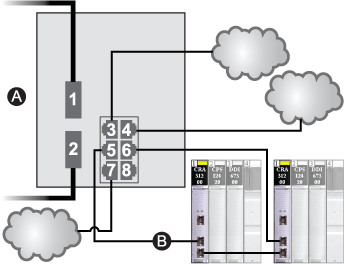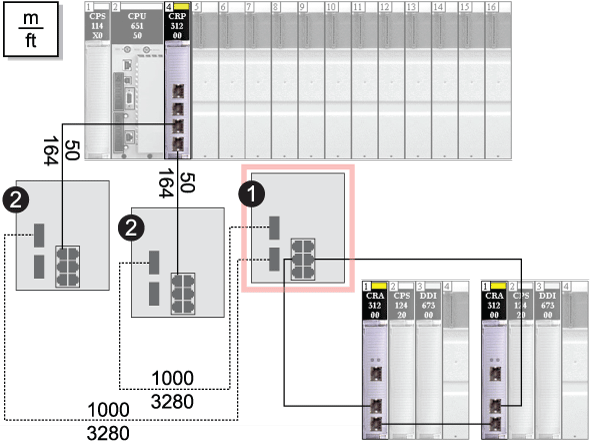Predefined Configuration File Name
C3_RIOMainRingFX_DIOSubRingTX_DIOCloudsVx.xx.cfg, where
Vx.xx references the version number of the file.
Use of this Predefined Configuration
In some applications, long distances (up to 15 km) may exist between consecutive remote I/O devices on a Quantum EIO network. You can span these distances using single-mode or multi-mode fiber optic cable on the main ring of your network.
The relationship between the main ring and the remote I/O sub-rings is essentially the same as with
only copper connections, with 2 key differences:
Devices Supported by this Predefined Configuration
The predefined configuration described here can be used with a DRS that supports either single-mode or multi-mode fiber cables.
Both switches have 6 ports that support copper connections. Fiber cable can be used only on the main ring, not on the sub-rings.
With single-mode fiber cable, you can achieve distances up to 15 km on the main ring. With multi-mode fiber cable, you can achieve distances up to 2 km.
Predefined Port Connections
For this predefined configuration, use the 2 fiber ports (ports 1 and 2) for the main ring (A) connections. Use the middle 2 copper ports (ports 5 and 6) to connect a remote I/O sub-ring (B) to the main ring. The sub-ring can contain only approved remote I/O devices. No distributed I/O devices are used in either the main ring or the sub-ring.
Ports 3, 4, and 7 on the DRS are available for additional optional connections, and can be used to connect distributed I/O clouds to the Quantum EIO system. Port 8 is reserved for
port mirroring, i.e., for monitoring the status of the ports you previously selected in the switch’s port mirror web page.
NOTE: The default configuration of port 8 has port mirroring disabled.
A
main ring (with 2 fiber connections)
B
remote I/O sub-ring (with two copper connections to some Quantum remote I/O drops)
|
Port
|
Type
|
Description
|
|
1
|
FX
|
fiber main ring connections
|
|
2
|
FX
|
|
3
|
100Base-TX
|
a distributed I/O cloud connection
|
|
4
|
100Base-TX
|
a distributed I/O cloud connection
|
|
5
|
100Base-TX
|
copper remote I/O sub-ring copper connections
|
|
6
|
100Base-TX
|
|
7
|
100Base-TX
|
a distributed I/O cloud connection
|
|
8
|
100Base-TX
|
port mirroring connection
|
NOTE: When you download this DRS predefined configuration file to a switch, the file provides a set of operating parameters that enable the switch to operate with high efficiency in the specified architecture.
Do not adjust the configuration parameters or alter the port usage from what is shown above. Changing the configuration parameters or the port assignments can compromise the effectiveness and accuracy of the switch and the performance of the remote I/O network.
You can enable/disable port mirroring and change the selection of the source ports that you want mirrored. Port mirroring is disabled by default. The destination port is set to port 8, and ports 1-7 are selected as source ports. Do not change the destination port. When using port mirroring, select the ports, for which you want to analyze the traffic, as the source ports. When you finish troubleshooting, disable port mirroring.
Supporting Fiber Links on the Main Ring
Remote I/O devices in the main ring often do not come equipped with fiber connectors. Therefore, some part of the main ring requires copper cable. This predefined configuration is usually implemented with at least 2 other DRSs configured to support
1 fiber and 1 copper connection to the main ring. Here is an example:
Note:
The dashed line represents fiber cable, and the solid line represents copper wire.
1
A DRS with a C3 predefined configuration file, which uses 2 fiber ports that support the remote I/O main ring and 2 copper ports that support a remote I/O sub-ring.
2
Two DRS with C5 or C6 predefined configuration files, which use only 1 fiber port. They support a copper-to-fiber and a fiber-to-copper transition. They enable the fiber-based network to connect to the copper ports on the 140CRP31200 in the local rack.

